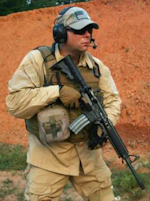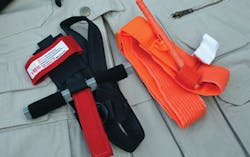Beyond the Band-Aid: Making Holes, Plugging Holes
Many of us pride ourselves on our ability to make holes. They give out trophies and plaques in the academy for the cadet most adept at making holes and that’s not necessarily a bad thing. Conscientious readers out there will practice regularly and maintain a high level of skill so that if and when the time comes, they can make holes straighter and faster than the bad guy who’s trying to put holes in them.
With all the emphasis on making holes, how often do we consider plugging holes; not just in victims and perps recently ventilated, but our partners and ourselves? It’s been fifteen years since the North Hollywood Bank Robbery, a scene that left dozens of victims lying about with multiple injuries. As the gun battle raged on, paramedics and EMT’s were unable to reach many of the victims without exposing themselves to hostile fire. In a situation such as that officers and their partners were left to make do with whatever they had available.
Beyond the Band-Aid
One big positive that has come out of the current Global War on Terror has been the close examination of battlefield medicine, specifically regarding buddy-aid and self-aid. Troops pre-paring for combat overseas are taught TCCC (Tactical Combat Casualty Care). The TCCC course teaches them how to apply effective stop-gap medical treatment to keep their fellow troops alive while awaiting professional medical care.
How does this apply to stateside law enforcement? It’s simple really. Bleeding to death from a gunshot wound in Chicago or Bagdad have the same result. If your femoral is severed your body doesn’t care where you happen to be on the planet. An arterial bleed will put you into irreversible shock in a matter of minutes; not five to ten but two to three. Vehicle crashes often result in partial or complete amputations. The ambulance is five minutes away and the victim has two minutes until they bleed to death.
You don’t need six years of medical school or even a paramedic certificate to stop-gap a life-threatening injury. If an 18 year old Army Private can be taught to save his buddy’s life then certainly anyone with a State Peace Officer’s Certification should be able to do so.
Preventable Death from Life-Threatening Injury
When we are talking about “preventable death” from life-threatening injuries we are discussing injuries that will kill the victim in a matter of minutes but can be treated on the street. These injuries fall into three major categories: Arterial bleeding from the extremities, Choking (loss of airway) and Tension Pneumothorax.
Life-threatening bleeding injuries that can and will kill the victim in a just a couple of minutes include partial or complete severing of the brachial artery in the arms and the femoral artery in the legs. Choking or loss of airway is just that, the airway has become blocked through an injury or foreign object.
Tension Pneumothorax occurs when air builds up in the chest cavity due to a puncture wound to one of the lungs. Humans can and do live with only one lung. However, when air builds up in the chest cavity between the injured lung and the heart pressure is put on the heart. The heart does not like this pressure and will eventually stop working.
I understand many of the EMT’s and Paramedics in the audience are likely apoplectic at my simplification of these injuries, but this is deliberate. Too many good guys will shy away from medical training because they think it’s too difficult or somehow equates to undo liability.
Let’s take just a quick moment to address the liability issue. If you carry a firearm as a tool of self-preservation you must understand that you may very well have to make the purposeful decision to take the life of a felonious attacker. If you act incorrectly you are “liable” for wrongful death, manslaughter, and even capital murder. To say that you don’t fear the liability of a capital murder charge but are afraid you’ll get sued by performing critical first aid on a victim is ridiculous to say the least. You feel comfortable taking a life but not trying to save a life?
Gear
The medical gear you’ll need for a proper trauma kit or “blow-out” kit is relatively easy to find and consists of the following items: a purpose built tourniquet (the CAT and MET-T are my favorites), pressure dressing and medical gauze, an NPA (Nasopharyngeal Airway) and a Chest Decompression Needle. Individual components and complete kits are available from North American Rescue, TQS Response, and Blackheart International.
Get the Training
Unfortunately, most LE agencies are satisfied to mandate CPR and Heimlich training and call it good. It is also disappointing but true that many local paramedics view trauma medicine and their arena and are hesitant conduct training. Again we fall back on the “we can’t train them, there’s too much liability”.
If you are carrying a gun because your job requires you to potentially ventilate bad guys you need to be able to plug the holes on the good guys and innocent victims. Off the top of my head, serious trauma medicine training can be had from Tactical Response in the form of their Immediate Action Medical 2-day course and from Gunsite Academy as their Emergency Medical Preparedness, a 3-day course.
We spend a lot of time and effort on the range working on our hole making skills, perhaps a few hours learning how to plug the holes might be appropriate as well. The gear and training are available. The rest is up to you.
About The Author:
Mr. Markel is a former United States Marine, Police Officer, and has worked as a professional bodyguard both in the U.S. and overseas. A Subject Matter Expert on Small Arms and Tactics, Markel has provided instruction to law enforcement and U.S. Military troops.
As a recognized author and writer, Paul has penned several hundred articles published in numerous professional journals and trade periodicals. Topics include firearms training, use of force, marksmanship, less-than-lethal force options, product reviews and evaluations, emergency medical care, and much more. Sought after as a public speaker, Mr. Markel is at home in front of an audience large or small.

Paul Markel
Mr. Markel is a former United States Marine, Police Officer, and has worked as a professional bodyguard both in the U.S. and overseas. A Subject Matter Expert on Small Arms and Tactics, Markel has provided instruction to law enforcement and U.S. Military troops.
As a recognized author and writer, Paul has penned several hundred articles published in numerous professional journals and trade periodicals. Topics include firearms training, use of force, marksmanship, less-than-lethal force options, product reviews and evaluations, emergency medical care, and much more. Sought after as a public speaker, Mr. Markel is at home in front of an audience large or small.
Follow Mr. Markel's instructional show: http://www.studentofthegun.com


